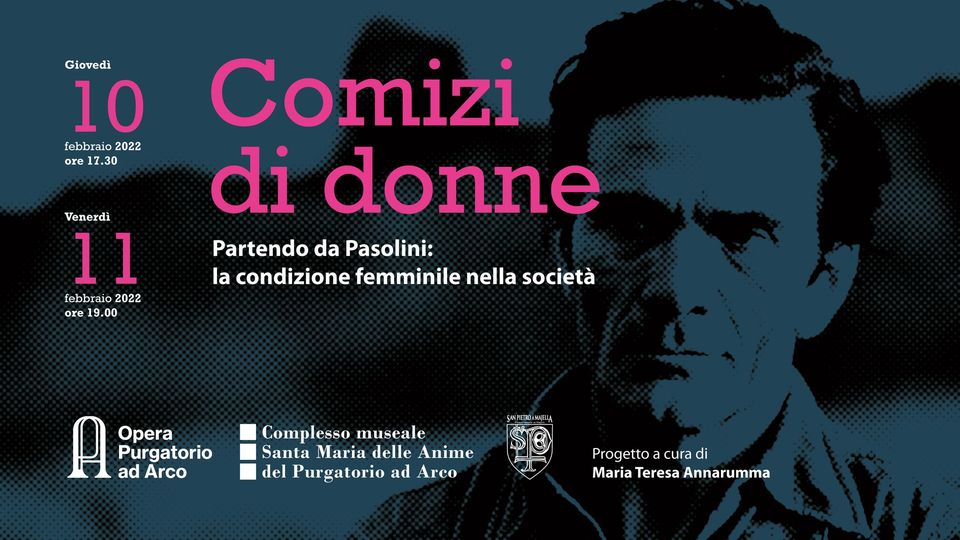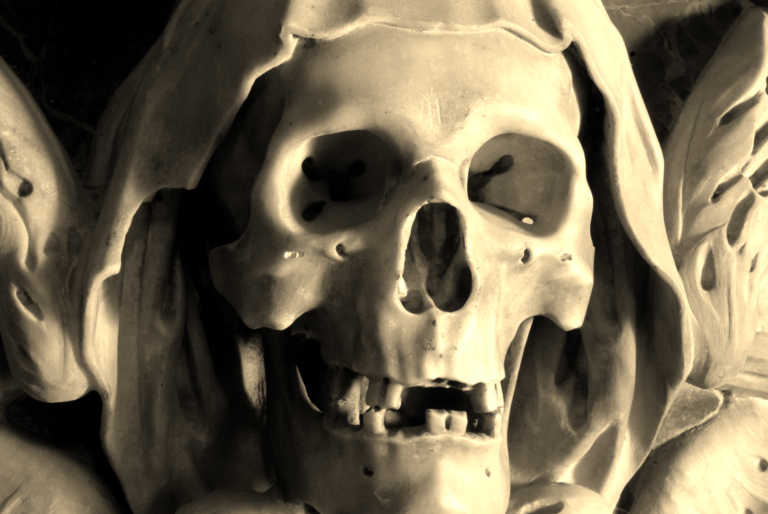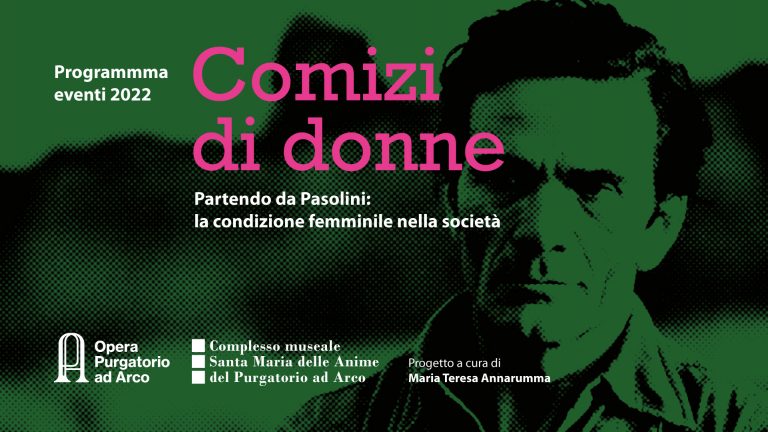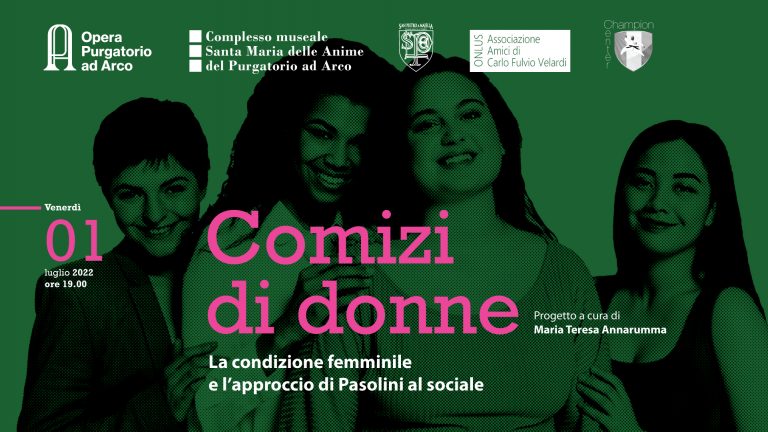Comizi di Donne. Starting with Pasolini: the condition of women in society.
Opening February 10, 2022 at 5.00 pm

“A work of art no matter how old or classic is actually, not just potentially, it is a work of art only when it lives in some individualized experience. (…) But as work of art, it is recreated every time it is esthetically experienced”.
“In art, as in nature and in life, relations are modes of interaction. (..) But they exist as actions and reactions in which things are modified. Art expresses, it does not state; it is concerned with existences in their perceived qualities, not with conceptions symbolized in terms. A social relation is an affair of affection and obligations, of intercourse, of generation, influence and mutual modification. It is in this sense that relation is to be understood when used to define form of art.”
(John Dewey, “Art as Experience”, 1934)
I came across this book and the writings of John Dewey during my time as guest researcher at MacBa in Barcelona when I was studying the model of the museum developed by Manuel Borja Villel in his time as director of the MacBa and later at the Reina Sofia in Madrid.
John Dewey was an American philosopher of the earlier part of the XX century, even if today we can say that far more has been theorised since his time concerning art and relation, some of it already touched on in these texts about Comizi di Donne, for example in the work of Craigie Hosfield, it is sadly true that his intuitions, almost a century later, are still far from being widely accepted and, most of all, are still far from being lived.
In 1934, Dewey was questioning the meaning of museum, art and exhibition and what they could be as part of a living culture in a country only slowly recovering from the great crash of 1928 and the economic devastation it caused. His was in many ways a very conservative and deeply divided society. And, of course he is writing not long before the Second World War which was to scramble and eventually reset a lot of the social dynamics that he knew. But what he anticipates, what he is reaching for, however conditionally, can be perceived as having a long, if also for long hidden, path, which was to find its expression, and its struggle with both its contradictions and its profound and revolutionary implications, in the work of two artists whose lives were critically formed by the war and the reconstruction that followed it. Two artists in different parts of a then divided Europe who were part of what can be seen now as a renaissance of art and culture, in East and West, that was to be followed by a crisis of ideology and of social cohesion. Traversing this flux Pier Paolo Pasolini and Jerzy Grotowski searched to find not only a language but a way of thinking and being that could answer to the profound questions that each was asking concerning individual and social being.
In fact, if Dewey was trying to open the perception of the people towards art, Pasolini and Grotowski, in front of the ruins of the second World War and the two newly predominant political models, determined by the victors, which were starting to be affirmed in their countries (capitalistic in Italy and socialist in Poland), imagined that to activate this kind of perception it was necessary to begin from a radical process of changed awareness. They took very different
perspectives but, in both cases, they came more and more to understand art and its production in its relational meaning which looks for conceptual connection with time, place, history and society. We can discover as much from their different paths as we can from that which they can be said to
have shared. And while the political structures and ideologies of the societies in which they lived came increasingly to be destabilised by the widening fractures and failures that were already inherent in the immediate post war years, each artist was driven to go further and further in their search for a resolution that neither would, or perhaps could, finally find.
It is a disquieting thought that we now can recognise the still corrosive legacy of the world that Pasolini and Grotowski struggled for meaning in, even in a time when so much appears to have changed. The conflict of East and West, the yet more fragmenting irresolution of the interrelationship of individual and the collective, the evident failures of systems of government in the face of disease and conflict, and the cruel inequalities become so much greater than in their time and that eat like a cancer in our society.
In front of the modernist models in which politics appeared to be putting apart centuries of cultural identity in Europe, a rupture, as Pasolini certainly perceived it, that was happening in society and in the self, decided to use art as a tool to think about how to go beyond what they saw as the impossibility of their present and they did it choosing to experiment with models of individual and collective awareness, to speak to the reality that lay beneath the compromised world they inhabited.
I will not claim here that they achieved some definitive outcomes with their research but I believe that it can be important to reappropriate some of their artistic and methodological choices now, in a time in which the compromises that were just being sketched out in the societies in which they worked have come to fracture our world and when the changes that they saw beginning, and which they protested, have lead to cycles of crisis, repeating with increasing severity.
As I have said Grotowski worked at first within a society of great cultural change, and a renaissance that is now rarely acknowledged. Released from the overriding imperative of reconstruction that had shaped the immediate post war years in Poland, and with the coming to power of what was effectively a proto-nationalist government following the death of Stalin and the consequent fall of his clients there was, for a period of between ten and fifteen years, a brilliant period of cultural renewal, most of all in the performative arts, in new music and jazz, in cinema, and, very significantly, in theatre. And theatre, traditional theatres, folk theatre, opera and operetta, flourished, as did political cabaret and student theatre, navigating with increasing freedom between church and state, the two conservative powers that dominated the society.
It was in student theatre that Grotowski, first developed his radical interpretation of what theatre and art could be, a way of thinking that would come to influence theatre in Poland and beyond for several generations. This stage of Grotowski’s work in some ways prefigures what was to come but not yet the crisis that it was to lead to. This was an increasingly physical theatre, and highly visual, a theatre of events and of confrontation. Over a relatively short time the work came to focus on the breaking down of the separation of performers and audience, becoming yet more physical and urgent in attempting to create instants of shared being, of feeling and understanding. In the struggle towards this breaking down of walls Grotowski left Poland first for America and the downtown experimental theatre scene of New York in the 1960’s, bringing with
him an idea of an almost viscerally experienced theatre. The most famous of his theatre groups from this period was “The Living Theatre” And his influence lives on until today in the Wooster Group of Liz Leconte, amongst others. But more and more he came to face a perhaps inevitable crisis and in a move that at the time shocked many he left New York for Italy.
And this comes to the point of why his work signifies beyond experimental and alternative theatre. In Italy he struggles to find a language, a method, a way of being, which erases all the separations and the conceptual framework that conventionally sustained theatre and performance. He attempts to find how to articulate what we might imagine as the co-being of once-audience and once-performer in an instant of becoming. This sounds metaphysical, but it wasn’t, it was imagined within the sphere of everyday experience. Of course, the performers could not come to this otherness that Grotowski was struggling to resolve, seemingly in his own thought. Some at the time said that he must have become mad, or was chasing a chimera, abandoning again what was known for something that could never be. For me, and for some others, this period of his work brings forward profound questions about the nature of experience in telling the world, questions of protagonism and authorship, and of performance and of who makes art and of what it may be. And these are questions that relate, very directly, to Pasolini, whose path follows a very different trajectory.
It can be said that for Grotowski performative arts can be tools to transform the perception and the presence of the artist, in a process imagined through two different steps: the awareness of the artist who supposes to cancel every kind of technique to get closer to the audience, and the awareness of the audience through a direct and intensely experienced relation with art in its making.
This perhaps is the point where Pasolini’s work most evidently is closest in its negotiation of new conceptions of authorship to the late experiments of Grotowski.: Pasolini decides to have (almost always) non-professional actors, in fact non-actors, to play in his films and to create a conversation without filters with the people, where their stories and their world, as though unmediated, were to be the creators.
But it is important to understand the context in which Pasolini has come to this. It may help to explain why Pasolini and Grotowski are significant to this project, and beyond it, and why Pasolini is at the beginning of the project and Comizi Di Donne at its end. And here I have returned to an interpretation theorised by Craigie Horsfield, whose work on these ideas has formed the matrix for much of the project, as I noted in an earlier text. My reading may be a little different but I think that it is useful in order to understand better Pasolini’s conception of history and the everyday, to see it alongside the work of Fernand Braudel and the social historians of the “longue durée”. Ideas that were developing at about the same time. Pasolini passionately believes that he is living through a cataclysmic change in culture and society in which the life and ways of being that had sustained and underpinned the world, generation after generation, the life of workers, of farmers, of everyday toil, the lives so often overlooked but which carried the true story of being, was in a single generation broken. The notion of the “longue durée” acknowledges this same sense of a profound world, unacknowledged, appearing as background, as the crowd, as the foot soldiers of armies, as the workers in the fields, and the factories…and the homes – and all the work of domesticity. It argues that this being, and their voices, are not lost, and must be recognised if we are to ever come to an understanding of our own world and its true history. For the historians the
record of this deep story could be traced through the records of ecclesiastical courts, through the records of the collectors of tithes, through the incidental and overlooked chronicles of villages and small towns. A whole world glimpsed through the cracks, the disregarded stuff that went unexamined behind the record of royal courts, of great events, of politicians, generals, and bishops, beneath the world, that is, of rulers and governors.
You can see from this the relation to Pasolini’s vision. He believed that through such a world unmediated there could be discovered a very different sphere of being and experience than the one that was destroying its own foundation, sweeping away, in its wilful ignorance, the stories of the people. It’s not too great a step to see in Pasolini’s work with non-actors a parallel with a pre modern theatre, although a very different understanding from that which had shaped Brecht’s notions of theatre and which were by then widely known. Pasolini’s players are closer to the relationships of the religious and secular performances of saints days and civic celebration: the bank manager as Pontus Pilate, the carpenter as Joseph…and so on. The audience recognised them as neighbors and fellow citizens, and their performance functioned, in some senses, as an allegory might. Even the casting of a known actor or artist comes to play a different function within this conceptual framework, as Pasolini people’s the drama with family, friends, and chance acquaintances. But even more than this Pasolini is drawn to the telling of tales that come from every level of society and are told, and listened to by all. It is the undertow of “the gospel according to Saint Mathew” that we could trace so vividly in our earlier film installation. And it comes to be the central preoccupation of his film work. Much of this was misunderstood at the time, or was overlooked, or even derided as commercial folly. The Decameron of Boccaccio, the Canterbury Tales of Geoffrey Chaucer, the Arabian Nights, all follow on from this thread that runs through the gospel of Mathew. These are the stories of the onlookers beneath the cross, the fishers and farmers and carpenters. The world is being told by those whose voices and perceptions went largely unrecorded. This longing to release, from the servitude of an imposed and imposter history, the lives of generations unacknowledged drives Pasolini’s search for a language that gives authorship, gives making, volition, and meaning, not to performers but to the living and the having lived. It is a radical step that searches to find its own language.
From this we may say that Grotowski can be described as having worked towards a process of individual experience within the social space of the theatre, of players and audience – until the final search to step outside what was known – a process of awareness which can be imagined to have been “vertical” (immediate, in the instant, urgent, physically insistent, and then searching for the erasure of all separation). Pasolini’s Process is a collective one, happening over time, and which can be imagined as being “horizontal”. But for each their drive was always toward the perception and the living experience of art related to an understanding of the story in a mutual exchange between “audience” and “telling”, as a conversation shared in its making, and that making happens between us.
This account is important to the understanding of how Comizi di Donne works as a contemporary art project and where it aims to go. It is intended to show the roots of the life and creation of art and to propose a different approach to curatorial work, a way of thinking and working that shares the same will of Grotowski and Pasolini: to understand art inside this conversation with the world.
We have of course come very far from Dewey, Grotowski, Braudel, and Pasolini, we live in a very different time, but, as we will see in the final part of Comizi di Donne, each may have a significance for us now.
If we hold to the necessity of collective and individual awareness as the starting point of living and creating art, the society in constant transformation needs a practice which finds a way to both respond attentively, to speak of ourselves and others together, and to speak of new being.
This is what artist, exhibition and curator should look to, and one of the great possibilities that we give to art is that it may become more strongly and more effectively the way to imagine alternatives to the world today. The world very much hurt by the pandemic but even before that hurt not only by the failure of the predominant social models, failures exacerbated in the face of disease and war, but also by the valuation of the individual and the individuals possibilities above all else. This last, the emphasizing of individual being – that works, of course, most significantly to the advantage of the wealthy and powerful – effects a separation of awareness that diminishes both the scope of common and shared being and, in consequence, the realisation of an individual’s full being in the world and in themselves. Moreover the single person, isolated from full and equal participation in the world, comes to be incapable of awareness of their own condition.
Comizi di donne starts from this understanding and translates it to the female condition, which has known, throughout recorded history, a process of cultural and economic exploitation. The work to mend, to heal, the deep tears in the fabric of society, that come from this – the separations that fracture the world, and the wounds to the common place of lives and to individual being – becomes ever more urgent now. Yes, so much has been done, but look around us, in the third decade of the twenty first century, how much is yet to be done! It is as if what had been gained just stopped, and began again to be lost. While, at the same time, so much around us appears to change. This is not only because of the “thinning”, the weakening of the coherence, of personal and collective awareness, but also because it looks to have been absorbed into a collective perception in which we have come to talk about women’s condition as being framed by extreme cases like rape, brutal sexual abuses, or in terms of femicide: the killing of women by men. But behind this there is the unremitting social and economic struggle of the everyday lived by millions of women across the globe. However within this reality, if we are attentive to it, if we look at what is happening behind the news cycle of crisis and sensation, we may discover currents of thought and action that can be imagined as the ground of a new dispensation, a new common ground. It is something that both Pasolini and Braudel apprehended, that in the commonplace of the everyday, in the intimacy and the community of lives lived unchronicled and often unattended to there may be understood not only the struggle to get by but also of how we may come to be sustained, a coming community, a new republic. We want to believe that art, amongst the many things it can be and do, may in its working, as thought and action, open a path for other ways of being. And this comes to the thought foreshadowed in Dewey’s writing, the recognition of the profound portent within the understanding of relation and art. And from it what art may be.
The next chapter of our project opens to these questions, and will make a radical proposal.
Maria Teresa Annarumma
“Nuova Repubblica Napoletana” di Marco Messina è prodotta da “Opera Pia Purgatorio ad Arco O.N.L.U.S.
“Opera Pia Purgatorio ad Arco” O.N.L.U.S. ringrazia l’Ing. Prof. Alberto Gaetti per la generosa collaborazione.





